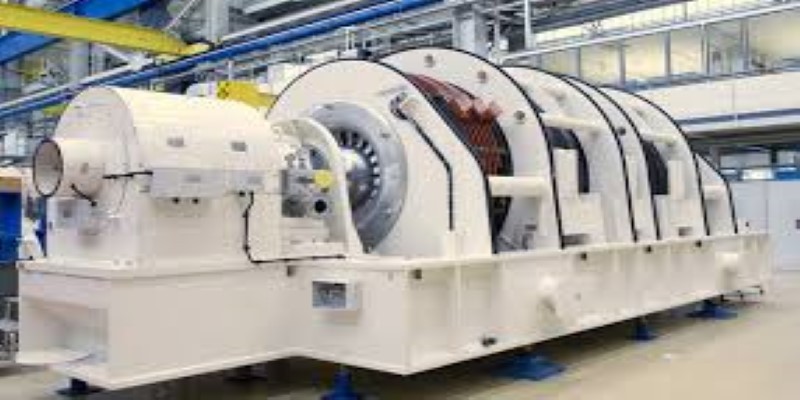
About Course
-
In Synchronous Generator (SG), a DC current is applied to rotor winding (produce rotor magnetic field).
-
The rotor is turned by a prime mover producing a rotating magnetic field.
-
The rotating magnetic field produces three-phase sets of voltages within the stator.
This lecture is about an (SG). The following subjects are treated;
- SG under load
- Synchronization
- SG on an infinite bus
- Effect of varying the mechanical torque
- Physical interpretation
- Active power
- Transient reactance
- Power transfer
Course Content
SYNCHRONOUS GENERATOR
-
#1 Introduction to Alternators/Synchronous Generator – Part 1
06:11 -
#2 Introduction to Synchronous generator – Part II
00:00 -
#3 Internal generated voltage of AC generator
06:13 -
#4 Equivalent circuit of Synchronous generator – Part I
12:42 -
#5 Equivalent circuit of Synchronous generator – Part II
00:00 -
#6 Equivalent circuit of Synchronous generator – Part III ( Drawing the equivalent circuit )
00:00 -
#7 Phasor Diagram of Synchronous Generator
00:00 -
#8 Power Flow and Power Output of Synchronous generator
00:00 -
#9 Induced Torque in Synchronous Generator
00:00 -
#10 Determining Equivalent Circuit parameters – Synchronous Gen ( Linear Method )
00:00 -
#11 Unsaturated Synchronous reactance – Numerical
00:00 -
#12 Synchronous Generator – Operating alone
00:00 -
#13 Numerical on Synchronous Generator – Part I
00:00 -
#14 Numerical on Synchronous Generator – Part II
00:00 -
#15 Numerical on Synchronous Generator – Part III
00:00 -
#16 Numerical on Synchronous Generator – Part IV
00:00 -
#17 Parallel operation of Alternators – Part I ( Advantages )
00:00 -
#18 Parallel operation of alternators – Part II Conditions required for Paralleling
00:00 -
#19 Parallel operation of alternators – Part III Basic terms to understand Synchronizing Procedure
00:00 -
#20 Parallel operation of alternators – Part IV “The Synchronizing procedure”
00:00 -
#21 Frequency-Power and Voltage – Reactive power characteristics of Synchronous Generator
00:00 -
#22 Numerical on Frequency vs Power chara ( Droop Curve ) of Synchronous Generator
00:00 -
#23 Operation of Synchronous Gen with Infinite bus #1 – Effect of changing field current (easy)
00:00 -
#24 Operation of Synchronous Gen with Infinite bus #2- Effect of changing mechanical torque (easy)
00:00 -
#25 Operation of Synchronous Gen with Infinite bus- Introduction to House Diagram
00:00 -
#26 Operation of Synchronous Gen with Infinite bus-Effect of changing mechanical torque
00:00 -
#27 Operation of Synchronous Gen with Infinite bus-Effect of changing Excitation ( Phasor )
00:00 -
#28 Parallel operation of Alternator of same Size – Changing governor setting
00:00 -
#29 Parallel operation of Alternator of same Size – Changing Excitation
00:00 -
#30 Parallel operation of Alternator of same Size – Numerical
00:00 -
#31 Parallel operation of Alternator – Adjusting operating points keeping frequency constant
00:00 -
#32 Synchronous Generators – Transients – Basic Idea
00:00 -
#33 Synchronous Generators – Transient Stability
00:00 -
#34 Synchronous Generators – Short circuit transients
00:00 -
#35 Synchronous Generators – Numerical on Short circuit transients
00:00 -
#36 Synchronous Generators – Rating (Part 1 – Voltage, frequency and Speed )
00:00 -
#37 Synchronous Generators – Rating (Part 2 – Apparent Power rating )
00:00 -
#38 Synchronous Generators – Rating (Part 3- Rated Power Factor)
00:00 -
#39 Synchronous Generators – Generator Capability Curves Part I
00:00 -
#40 Synchronous Generators – Generator Capability Curves Part II
00:00 -
#41 Synchronous Generators – Generator Capability Curves ( Numerical )
00:00 -
#42 Synchronous Generators – Short Time operation and Service Factor
00:00
Student Ratings & Reviews

No Review Yet
